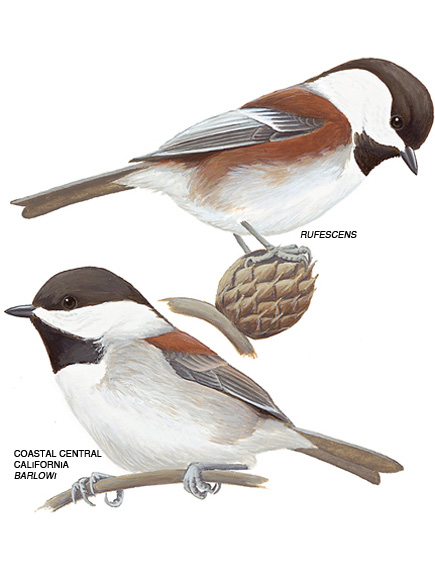The chestnut-backed chickadee is inquisitive about people, and stays the postbreeding and winter weather months looking noisily in mixed-species flocks. As opposed to other parids (except for the hill chickadee), it forages higher in the the canopy of high conifers. This types is the tiniest chickadee in Southern The united states. One of the 3 “brown-backed” types (along with boreal and gray-headed), its nominate subspecies is the most thoroughly shaded parid. Polytypic. Duration 4.8" (12 cm).
Identification The saying color of the rear is unique, but it deviates in strength. The cap is darkish, treatment to dark-colored at its cheaper side from the expenses through the eye; the oral cavity is white; the bib is black; the rear and rump are rufous; the increased side coverts are surrounded white; the chest and waist are whitish; the edges and flanks are shiny rufous or unexciting darkish, based on the subspecies; the longest tail is darkish grey.
Geographic Difference Three subspecies. The extensively allocated rufescens is the most vibrant, with a wealthy saying rear, shiny edgings on the increased side coverts, and substantially shiny rufous flanks. The other 2 subspecies are limited to seaside California; they change especially on the underparts. In Marin Nation, the neglectus has decreased, light saying flanks that do not comparison plainly with the white chest and belly; barlowi, found from San Francisco to southern region Father christmas Barbara Nation, has grey flanks, tinged with olive darkish.
Similar Species The boreal chickadee also has a darkish cap and wealthy darkish factors and flanks, but it has primarily grey cheekbones, does not have a rufous film on the rear and rump, and reveals no shiny side edgings.
Voice Call: a hoarse, high-pitched, fast sik-zee-zee or just zee-zee; also a feature razor-sharp chek-chek. Song: no whistled tune is known.
Status and Submission Common. Year-round: Coniferous jungles, especially of Douglas fir, and combined and deciduous jungles. Dispersal: postbreeding actions have been mentioned to higher levels in English The philipines and to cheaper levels in Or. Vagrant: walks irregularly national as far as northern western Alberta and satisfied southern region of its regular variety to lower Florida.
Population Its variety has enhanced southward and eastward in latest generations from moist seaside parts to the more dry lower San Francisco Bay place and the wooded Sierra The state of nevada in Florida. Statistics appear to be constant in the southern region part of the variety, but latest diminishes in the inside development place have increased preservation issues.
Identification The saying color of the rear is unique, but it deviates in strength. The cap is darkish, treatment to dark-colored at its cheaper side from the expenses through the eye; the oral cavity is white; the bib is black; the rear and rump are rufous; the increased side coverts are surrounded white; the chest and waist are whitish; the edges and flanks are shiny rufous or unexciting darkish, based on the subspecies; the longest tail is darkish grey.
Geographic Difference Three subspecies. The extensively allocated rufescens is the most vibrant, with a wealthy saying rear, shiny edgings on the increased side coverts, and substantially shiny rufous flanks. The other 2 subspecies are limited to seaside California; they change especially on the underparts. In Marin Nation, the neglectus has decreased, light saying flanks that do not comparison plainly with the white chest and belly; barlowi, found from San Francisco to southern region Father christmas Barbara Nation, has grey flanks, tinged with olive darkish.
Similar Species The boreal chickadee also has a darkish cap and wealthy darkish factors and flanks, but it has primarily grey cheekbones, does not have a rufous film on the rear and rump, and reveals no shiny side edgings.
Voice Call: a hoarse, high-pitched, fast sik-zee-zee or just zee-zee; also a feature razor-sharp chek-chek. Song: no whistled tune is known.
Status and Submission Common. Year-round: Coniferous jungles, especially of Douglas fir, and combined and deciduous jungles. Dispersal: postbreeding actions have been mentioned to higher levels in English The philipines and to cheaper levels in Or. Vagrant: walks irregularly national as far as northern western Alberta and satisfied southern region of its regular variety to lower Florida.
Population Its variety has enhanced southward and eastward in latest generations from moist seaside parts to the more dry lower San Francisco Bay place and the wooded Sierra The state of nevada in Florida. Statistics appear to be constant in the southern region part of the variety, but latest diminishes in the inside development place have increased preservation issues.

No comments:
Post a Comment